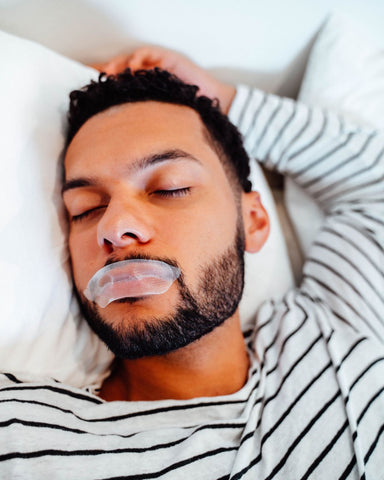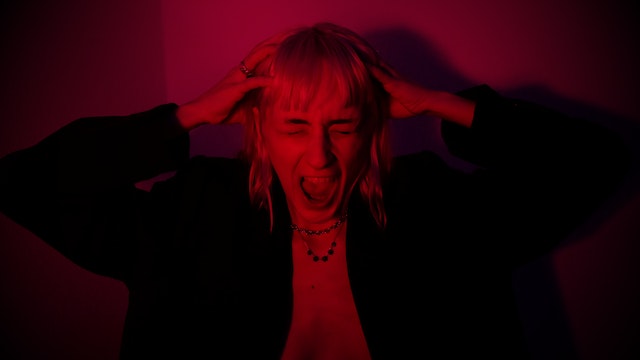Have you ever heard someone joke about their “sleep paralysis demon?”
While these jokes may be silly, the actual experience of sleep paralysis is terrifying. Imagine being literally paralyzed with fear in your own bedroom, unable to move or cry for help.
Some people even experience awful visual, physical, or auditory hallucinations, feeling as if there is a frightening presence in the room with them.
Maybe it’s happened to you before. Research shows that over seven percent of the general population will experience sleep paralysis at some point in their lifetime.
Why does sleep paralysis occur? How long does sleep paralysis last? And what can we do to prevent it?
Why Does Sleep Paralysis Occur?
Picture it: you wake up from a deep sleep and feel someone (orsomething) laying on your chest. Everything feels wrong – you have a knot in your stomach.
You try to cry out for help but you can’t move or speak. It feels like something out of a horror movie.
The sensation seems to last a lifetime. Finally, it ends. You open your eyes, heart beating rapidly. Was it just a dream?
While we typically think about the line between sleep and wakefulness as being completely separate, sleep paralysis challenges these boundaries.

Much is still unknown about sleep paralysis. However, we do have a basic understanding of what causes this phenomenon. So why does sleep paralysis occur?
For those who experience sleep paralysis, their waking lives and their dream lives intertwine and overlap.
During rapid eye movement (REM) sleep, we experience a brief loss of muscle control commonly known as REM atonia.
REM atonia serves as a method of protection that prevents us from acting out our dreams, keeping our physical bodies safe and still while we rest.
Once REM sleep ends and we experience a state of wakefulness, the muscle paralysis caused by REM atonia ends.
During sleep paralysis, however, REM sleep ends and we wake up while REM atonia is still active.
That means our brains are awake while our bodies are not. Due to this, sleep paralysis can be thought of as a type of parasomnia, or abnormal sleep behavior.
@somnifix #stitch with @xharwant #sleepparalysis is spooky. 😨👻 Here’s why it happens! #remsleep #sleepcycles #didyouknow #greenscreen ♬ Radetsky March Classic Classic(829541) - Yuumi Iida
When you become aware of the inability to move, panic sets in. This sort of mixed state of consciousness leads to strange mental and physical imagery, according to parasomnia researchers.
So how long does sleep paralysis last? Frightening hallucinations can alter our perception of the duration of these episodes.
Hallucinations: How Long Does Sleep Paralysis Last?
While episodes usually last anywhere from a couple of seconds to a few minutes, they can feel like hours.
As we’ve mentioned, these scary, dream-like experiences frequently include terrifying hallucinations.
Around 75 percent of all people who experience sleep paralysis episodes claim to experience hallucinations that are recognizably distinguishable from regular dreams.
Moreover, a whopping 93 percent of people who have experienced sleep paralysis report feeling extreme fear during or after the episode.
In a separate study, 52.9 percent of respondents said they ranked their fear as a 10 during sleep paralysis episodes on a one to 10 scale.

As if the feeling of being paralyzed isn’t terrifying enough, hallucinations only add to the fear.
Episodes that occur upon waking are commonly called hypnopompic hallucinations, while episodes that occur while falling asleep are called hypnagogic hallucinations.
Common hallucination scenarios include:
- Chest pressure hallucinations: these include the feeling of suffocation caused by the sensation of pressure on the chest or other parts of the body
- Intruder hallucinations: these hallucinations involve the feeling of a dangerous presence or person in the room during a paralysis episode
- Vestibular-motor (V-M) hallucinations: these are caused by out-of-body feelings or sensations of movement
Many people want to put a stop to the distressing and uncomfortable hallucinations associated with sleep paralysis.

Understanding the root cause of your sleep paralysis is key to putting a stop to it for good.
When answering the question “why does sleep paralysis occur?” we must turn our attention to some of the top causes of these episodes.
Some may even begin to fear sleep due to hallucinations associated with sleep paralysis episodes, worsening sleep deprivation.
Common Causes of Sleep Paralysis
If you have experienced sleep paralysis, you’re likely extremely curious to understand the cause.
You might even chalk it up to a paranormal experience. But before you jump to spooky conclusions, let’s examine what causes the muscle paralysis caused by REM atonia to overlap with wakefulness.
Potential causes include:
- Insomnia and disrupted sleeping patterns
- Jet lag
- Sleep disorders such as narcolepsy, which causes episodes of sudden, unpredictable sleep
- Mental conditions such as anxiety or panic disorder and Post-Traumatic Stress Disorder (PTSD)
- A family history of sleep paralysis
Therefore, it makes sense that addressing sleep issues and taking care of your mental health can lessen or eliminate sleep paralysis episodes.
Paralyze Sleep Paralysis For Good
If you want to put an end to recurring sleep paralysis episodes, it may be as simple as correcting your sleep patterns.
While distressing sleep paralysis episodes might make you feel afraid to sleep, avoiding sleep and worsening sleep deprivation can increase your risk of experiencing sleep paralysis when you finally do rest.
Therefore, it’s vital to establish healthy sleep cycles that include regularly getting six to eight hours of rest each night. No more, no less.

Moreover, you should fall asleep at around the same time each night and wake up at the same time every morning, no matter the day of the week.
Try to exercise regularly, but avoid strenuous activities four hours before bed.
You should also aim for sunlight exposure as soon as you wake up to signal to your circadian clock that it’s daytime. Then, avoid blue light sources at night that your body can confuse for sunlight.
That means staying off of your phone, computer, or tablet and away from your television two to three hours before bed, as these sources of blue light throw off melatonin production.

Avoid big meals, smoking, or consuming alcohol and caffeine before sleeping.
If you have a habit of sleeping on your back, try to avoid it. Research suggests that this sleeping position is linked to an increased risk of experiencing sleep paralysis.
This may be due to the fact that snoring is more likely when sleeping on your back, throwing off our oxygen intake and sleep patterns while we rest.
When left unchecked, snoring leads to sleep disorders like obstructive sleep apnea (OSA). If your sleep paralysis persists and begins to disrupt your daily life, visit a sleep specialist to rule out sleep disorders like OSA and narcolepsy.
Furthermore, prevent snoring by putting an end to mouth breathing at night.
Stop Mouth Breathing For Improved Sleep Patterns
Improved sleep patterns may reduce or eliminate sleep paralysis.
That said, mouth breathing and snoring disrupt sleep patterns. Therefore, by putting an end to mouth breathing, your sleep cycles will follow suit.
Mouth breathing is notorious for causing snoring by forcing airway tissues to fall backward. This obstructs the airway. Tissues then vibrate together, creating snoring.

So how do you stop mouth breathing at night? Tape your mouth shut before you go to bed.
Mouth tape prevents mouth breathing and promotes a proper tongue posture that reduces your risk of snoring, leading to quality, sound sleep.
Additionally, nasal breathing is known to place the body in a blissful state of rest and relaxation by activating the parasympathetic nervous system, while mouth breathing activates the fight-or-flight stress response.
Therefore, nasal breathing may lessen our general anxiety and improve mental health, potentially helping to prevent sleep paralysis altogether.
Our Mout Strips are created from recycled materials and feature a comfortable, non-irritating gel-like adhesive that’s perfect for any skin type.

SomniFix also offers a breathing vent in the middle of our strips, perfect for emergency mouth breathing caused by overnight congestion.
Exorcise your “sleep paralysis demons” away with SomniFix tonight!



